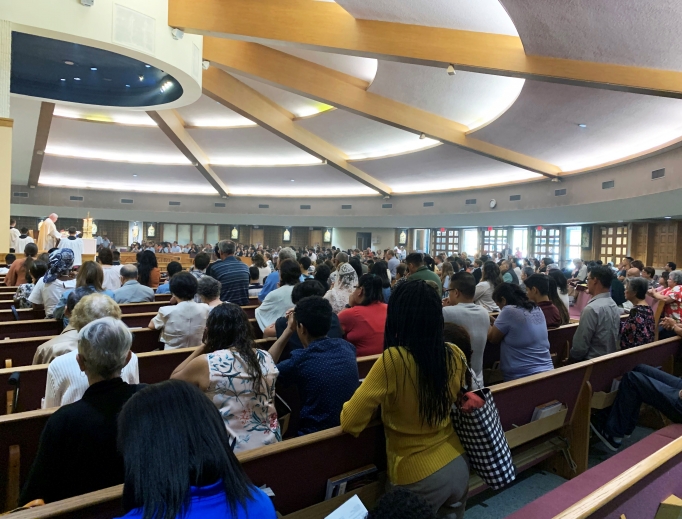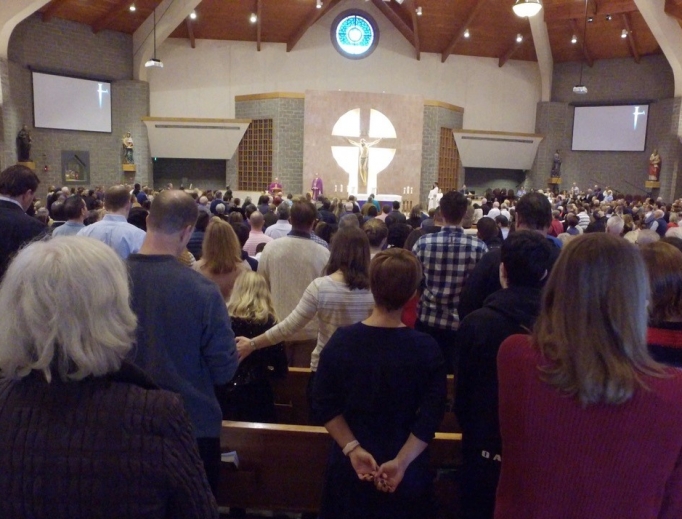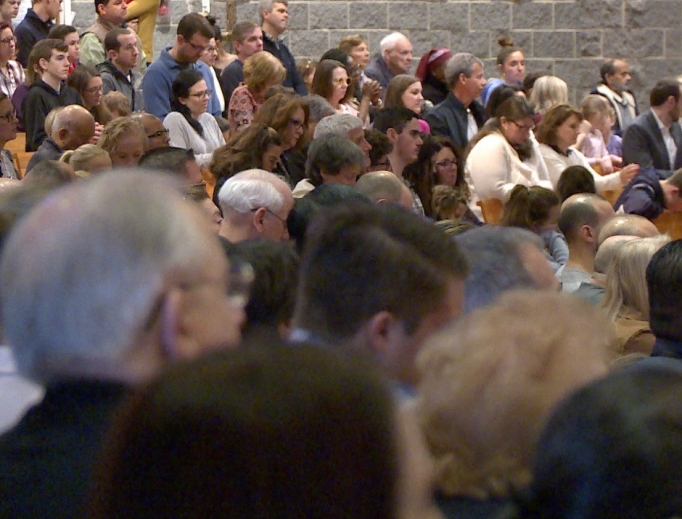Creating Catholic Community: The Story of Two Megachurches
How pastors, staff and volunteers ar St. Matthew’s in Charlotte, North Carolina, and St. Elizabeth Ann Seton in Houston foster fellowship.

“Anywhere but there,” Carolyn Klika thought when she learned that St. Matthew’s was the nearest Catholic church to her home after she moved to Charlotte, North Carolina. Although there is no national count, with almost 11,000 registered households, St. Matthew’s is thought to be the largest Catholic congregation in the United States.
Klika began attending due to its proximity while she looked for a smaller parish.
But, instead, she ended up staying and is now the co-director of parish hospitality. “I felt a spirit there,” she said in an interview with the Register. “I thought, ‘Wow! Christ is alive here,’ and I found myself going back week after week.”
Huge congregations might seem impersonal, but pastors at two of the largest Catholic parishes in the U.S. say that it can be just the opposite — there are more opportunities to find people with your same interests and connect to community.
At St. Matthew’s in Charlotte, there are 10, 975 registered households, and at St. Elizabeth Ann Seton in Houston, there are 9,993.
Each parish, on its own, is bigger than 10 of the dioceses in the U.S.
Both churches manage with four priests to serve their large congregations. Father Patrick Hoare, pastor of St. Matthew’s, explained his parish does not seem so big once people get involved in some of the 103 ministries, such as bereavement support, Bible studies, a soup kitchen, faith formation and Alcoholics Anonymous. “There’s people enjoying the same thing, and, suddenly, you have a family within the family,” he said.
“Even in a small church, not everyone knows each other,” said Father Stephen Reynolds, pastor of St. Elizabeth’s. “The way people interact on a human level is with smaller groups of individuals. The challenge in a large parish is for people to find groups where they feel they belong.”

Mass is celebrated for the Solemnity of the Assumption at St. Elizabeth Ann Seton in Houston.
Both pastors point to the potential for greater opportunities. For instance, they can more easily afford to bring in national speakers and the substance of the talk is the same whether it is heard by 200 or 2,000 people. At St. Matthew’s, having 500 confirmation candidates makes it possible to rent out a camp for a weekend retreat and then invite smaller parishes unable to afford such an endeavor to join in.
“There is an economy of scale, in terms of administration,” Father Reynolds said. “It’s just as easy to send out 5,000 letters as 10,000.” Whatever the activity, a large parish can be a greater source for donations, volunteers, adorers for adoration and expertise, he explained. “We certainly have more than a critical mass of people, so if something needs to be done, there is always someone to do it.”
Unity Not Diversity
The size of both churches is a reflection of the population influx into their states with many Catholics among them.
Franciscan missionaries from Europe brought Catholicism to the Texas region of New Spain in the 1600s, but the first Catholic church in Houston did not open until 1839. Mexicans were not welcomed at that time, but in 1912, the first Mexican Catholic Church opened. By 1972, the Church there began working to erase racial segregation. In the last few decades, Catholic immigrants have included Vietnamese, Filipinos, Chinese, Koreans and Indians. According to the Archdiocese of Galveston-Houston’s website, the Church there serves 1.7 million Catholics in 146 parishes, equaling 26% of the total population.
As a regional parish as opposed to a neighborhood parish, Father Reynolds explained that people are spread across a wider area, which has the advantage of greater cultural diversity. Masses at St. Elizabeth’s are celebrated in three languages every weekend: six in English, three in Spanish and one in Vietnamese. There are Bible studies and education programs in those languages, too.
“There are people here from every continent except Antarctica,” Father Reynolds said. “At our Church, one talks about diversity. I don’t see diversity — I see unity. They are all united by the same faith, regardless of what part of the world they are from.”
Patti Bergholtz began working as the secretary at St. Elizabeth’s 25 years ago, when there were only 4,000 families. Although the number has more than doubled, she said that the church can feel very intimate, too. When a new family registers, they are given a list of all the activities so that they can connect with others with their same interests. “Everyone is individual to God,” Bergholtz said. “Just come to adoration — open 24 hours a day — and you will feel alone with him. Even though it’s a large parish, it’s comforting to know that you can spend an hour with God.”
From Mission to Mega
Before 1960, North Carolina was considered mission territory, with less than 1% of the state’s population being Catholic: 34,000. In 1980, there were fewer than 100,000 Catholics. “Now, every church in North Carolina is bursting at the seams, and new ones are being built,” according to Patricia Guilfoyle, editor of Catholic News Herald diocesan paper for the Charlotte Diocese. “It’s a wonderful problem to have.”
Officially, she said there are only 258, 000 faithful registered in the diocese, but based on parish census data, there are probably 400,000 to 450,000 Catholics total.
Guilfoyle explained that there are a lot of Catholic immigrants and retirees who tend not to register with a parish. “Catholics are moving here from all over the world — Nigeria, Cameroon, Central and South American, Poland, the Ukraine, India and Russian. It’s a very vibrant place to live; a real blessing.”


St. Matthew’s parish was established in 1986, when 237 families began attending Sunday Mass in a borrowed movie theater. Father Hoare’s first assignment was at St. Mark’s in Huntersville, with around 3,500 families (now at about 5,000), so he said that coming two years ago to a church with more than double that did not intimidate him. “There’s a spirit of excitement and possibilities here,” he said. “The world says no one believes anymore. I say, okay, come to my church.”
Pastoring such a large flock requires delegating to a leadership team of eight capable people, Father Hoare explained. “I have come to realize that I can’t be involved in everything. Administration is a ministry, too.”
Two unique programs that are possible due to St. Matthew’s size are the food pantry and “yoUniversity,” which offers three trimesters of around 25 educational classes. Parishioners with a theology background often help lead pre-packaged studies, and priests help out with the Bible studies.
The parish owns its own warehouse, which distributes food to the poor in Appalachia, Haiti and Jamaica. “This is our 17th year doing a World Hunger Drive,” Father Hoare said. “It’s a six-week event where we pack 320,000 meals in one day, along with cereal, rice, beans and a lot of other things.”
Parishioner Responses
Chrissy Wilson, a parishioner for 25 years and director of the “Christ Renews His Parish” program, explained, “Once you make the decision to become an engaged parishioner, the Mass experience and sense of belonging and community can be life changing. I personally feel that the size of the parish is one of St. Matthew’s best assets.”
It is the many opportunities that parishioner Anne Ibekwe attributes to making her feel at home. “When I first attended St. Matthew’s in 2006, I was overwhelmed by the size,” she said. “I told my husband that we don’t belong here.”
Her husband’s response caused her to re-evaluate. “Whatever you are looking for is here at St Matthew’s,” he said. “You are the church … and you can find what you are looking for if you devote yourself.”
His perspective inspired Anne to get involved in a number of activities, and she has been hosting some of the small- group education programs for six years. “My husband was right,” she said. “These small groups made the megachurch which seems like an ocean become a small pond. What I cherish most about our megachurch is that we are a welcoming parish, connected in Christ and moved by the Spirit.”
Patti Armstrong writes from North Dakota.
Numbers for 2019 at St. Matthew’s
- Up to 21 extraordinary ministers of Holy Communion during each of the 10 weekend Masses, which 10,000 to 12,000 attend.
- 143 altar servers.
- 475 First Communicants
- 500 Confirmation candidates
- 3,700 faith formation students
- 520 Catechists
- Over 7,000 volunteers help to run 103 active ministries.
Helping People Feel Like Individuals at a Megachurch
When new parishioners register at mega-parishes St. Matthew’s or St. Elizabeth’s, they are given a list of parish opportunities to help them connect with like-minded people.
The key, according to Carolyn Klika, co-director of hospitality at St. Matthew’s along with Michelle Sutter, is to make every parishioner feel like an individual. “When people register, there are two things we want to know,” she explained. “1) What do you need to feel a full part of the parish family — such as a Bible study — and to grow closer to Christ? 2) What are your God-given gifts, and where are you called to serve?”
One of St. Matthew’s “yoUniversity” courses is “Moving on After Moving in” to help new people get acclimated. There is also a periodic welcome breakfast for newcomers.
Volunteers for greeters and the welcome desk receive training with tips that include questions and comments to help people to feel welcome.
To understand where parishioners are spiritually, St. Matthew partners with Gallup and the Center for Applied Research in the Apostolate (CARA) to conduct two different in-pew surveys on an alternating schedule. The surveys get at the questions and needs of parishioners as well as an understanding of their level of engagement, spiritual life and satisfaction. The results help the priests and leadership team consider how they can better serve the parish.
“In every large organization, you are never going to know everyone,” Sutter said. “Even in a small parish there are clusters. You get to know people by the doors that you open.”
— Patti Armstrong
,
- Keywords:
- large parishes
- parish life
- parishes
- patti armstrong

















